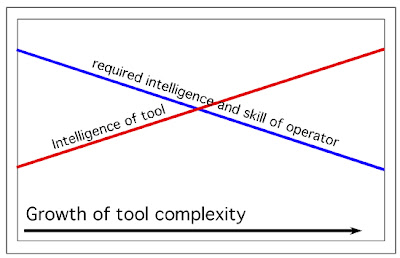
 These simple charts are intended to illustrate the relationship between the development of more efficient tools, and the required level of skill and attention in their use. In the last century, workers in manufacturing went from skilled labor to less and less skilled labor, as the tools and tool processes became more and more efficient. The inverse relationship between necessary skill and intelligence seems to apply in the computer programming world as well. The first chart concerns growth in tool complexity, accuracy and complexity, and the second correlates the same effect with David Pye's concepts, workmanship of risk and workmanship of certainty. As tools are developed to eliminate margin of error, or to compensate for the inattention of the operator, required skill declines.
These simple charts are intended to illustrate the relationship between the development of more efficient tools, and the required level of skill and attention in their use. In the last century, workers in manufacturing went from skilled labor to less and less skilled labor, as the tools and tool processes became more and more efficient. The inverse relationship between necessary skill and intelligence seems to apply in the computer programming world as well. The first chart concerns growth in tool complexity, accuracy and complexity, and the second correlates the same effect with David Pye's concepts, workmanship of risk and workmanship of certainty. As tools are developed to eliminate margin of error, or to compensate for the inattention of the operator, required skill declines.These simple charts may help to explain why so many wood workers like to work with hand tools. Skill and attention are matters that create feelings of self-worth and accomplishment. They are the soft side of harsh reality, and the human component that compels engagement in physical and cultural reality.
Hi Doug, I've used David Pye's books with my design classes in school also, will start a Rietveld Red/Blue chair project with 3rd year kids tommorow (boys v. Girls) it will be interesting to see how they will get on finding out the correct seat & back angles for max. comfort. Struggling this session to fit in much craftwork in 3 lessons (2.75 hours per week)
ReplyDeletewill keep you posted on the chairs. all the best. John.